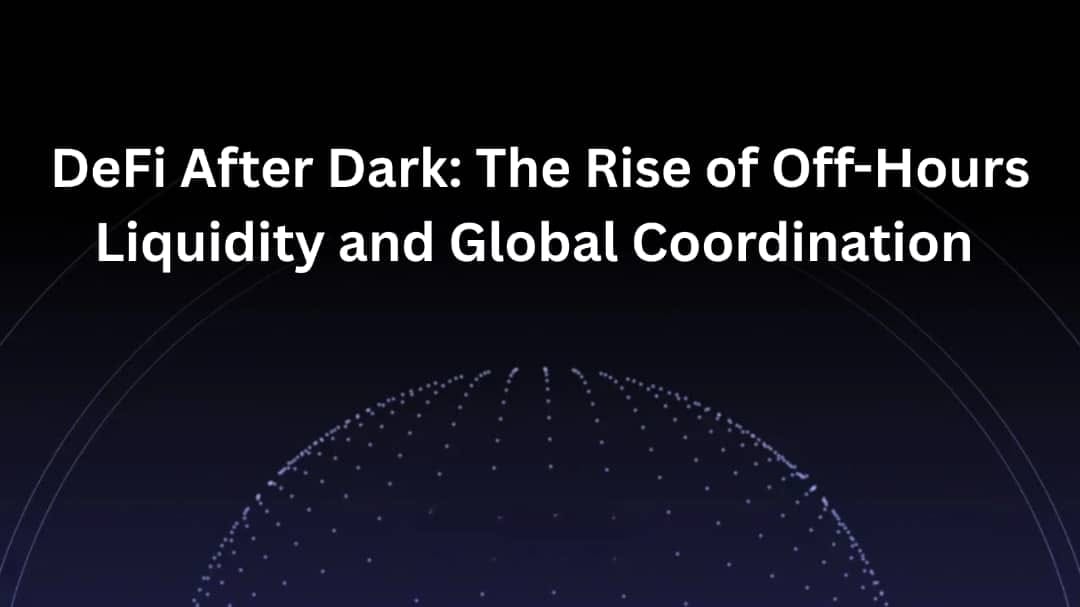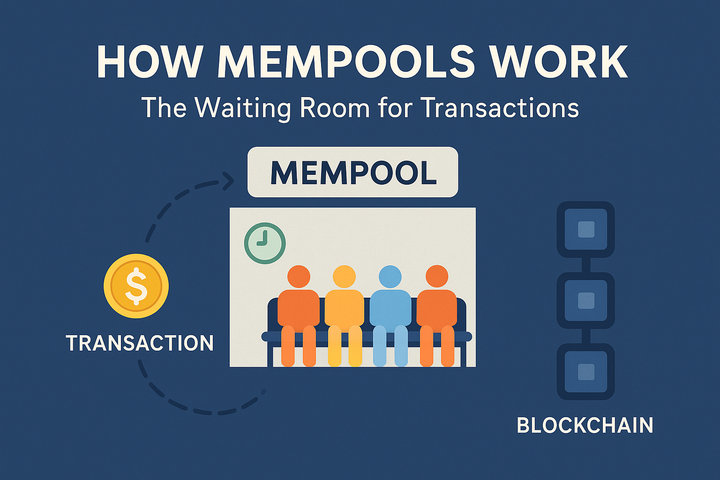DeFi After Dark: The Rise of Off-Hours Liquidity and Global Coordination

Introduction
Decentralized Finance (DeFi) has revolutionized the financial landscape, enabling users to engage in a myriad of financial activities without the need for traditional intermediaries. As the DeFi ecosystem continues to evolve, a new phenomenon has emerged: off-hours liquidity. This article explores the implications of time zones, night liquidity, and cross-region flow on DeFi protocols and traders, shedding light on how these factors influence market dynamics and opportunities.
1. Understanding DeFi and Its Global Nature
1.1 What is DeFi?
Decentralized Finance, or DeFi, refers to a suite of financial services built on blockchain technology, primarily Ethereum. These services include lending, borrowing, trading, and yield farming, all of which operate without centralized control. DeFi protocols leverage smart contracts to automate processes, ensuring transparency and security.
1.2 The Global Reach of DeFi
One of the defining characteristics of DeFi is its global accessibility. Unlike traditional finance, which is often constrained by geographical boundaries and operating hours, DeFi operates 24/7. This continuous operation allows users from different time zones to participate in financial activities at any time, creating a truly global marketplace.
2. The Impact of Time Zones on DeFi Liquidity
1. Time Zones and Market Activity
The world is divided into multiple time zones, each with its own peak trading hours. In traditional finance, this results in varying levels of market activity depending on the time of day. In DeFi, however, the impact of time zones is more nuanced. While the market is always open, the concentration of traders and liquidity providers can vary significantly based on the time of day.
2. Peak Trading Hours
During peak trading hours in major financial centers, such as New York, London, and Tokyo, liquidity tends to be higher. This is when most traders are active, leading to tighter spreads and more efficient price discovery. Conversely, during off-hours, particularly at night in these regions, liquidity can dwindle, resulting in wider spreads and increased slippage.
3. Night Liquidity: A Growing Trend
As DeFi matures, the concept of night liquidity has gained traction. Night liquidity refers to the availability of liquidity during off-hours, particularly in regions where traditional markets are closed. This phenomenon is driven by several factors:
- Global Participation: DeFi attracts participants from around the world, allowing for continuous trading even when major markets are closed. Traders in Asia, for example, can take advantage of opportunities while European and American markets are offline.
- Automated Trading: The rise of automated trading strategies, including bots and algorithms, has contributed to night liquidity. These systems can operate around the clock, executing trades based on predefined criteria without human intervention.
- Yield Farming and Staking: Many DeFi protocols offer yield farming and staking opportunities that incentivize users to provide liquidity at all hours. This creates a more balanced liquidity distribution throughout the day and night.
3. Cross-Region Flow: Bridging Time Zones
3.1 The Importance of Cross-Region Liquidity
Cross-region flow refers to the movement of liquidity across different geographical areas. In the context of DeFi, this flow is crucial for several reasons:
- Arbitrage Opportunities: Traders can exploit price discrepancies between different regions, taking advantage of variations in liquidity and market sentiment. This is particularly relevant during off-hours when certain markets may be less efficient.
- Risk Mitigation: By diversifying liquidity sources across regions, traders can reduce their exposure to localized market risks. This is especially important in volatile markets where sudden price movements can occur.
- Enhanced Market Depth: Cross-region liquidity contributes to overall market depth, allowing for larger trades to be executed without significantly impacting prices. This is essential for institutional investors looking to enter or exit positions.
3.2 Mechanisms for Cross-Region Liquidity
Several mechanisms facilitate cross-region liquidity in DeFi:
- Decentralized Exchanges (DEXs): DEXs like Uniswap, SushiSwap, and PancakeSwap enable users to trade assets directly from their wallets, providing access to liquidity from around the world. These platforms often aggregate liquidity from multiple sources, enhancing trading efficiency.
- Liquidity Pools: Liquidity pools allow users to contribute assets in exchange for a share of the trading fees generated by the pool. This incentivizes liquidity provision across different time zones, as users can earn rewards regardless of when they participate.
- Cross-Chain Solutions: As the DeFi ecosystem expands, cross-chain solutions like Polkadot and Cosmos are emerging to facilitate liquidity movement between different blockchains. This interoperability enhances cross-region flow and allows users to access a broader range of assets and opportunities.
4. The Role of Protocols in Off-Hours Liquidity
4.1 Protocol Design and Incentives
DeFi protocols play a crucial role in shaping off-hours liquidity. The design of these protocols, including their incentive structures, can significantly impact user participation during non-peak hours.
- Dynamic Fee Structures: Some protocols implement dynamic fee structures that adjust based on market conditions. By lowering fees during off-hours, protocols can incentivize liquidity provision and trading activity when participation is typically lower.
- Incentivized Liquidity Mining: Liquidity mining programs reward users for providing liquidity to specific pools. By offering additional incentives during off-hours, protocols can attract liquidity providers who may otherwise be inactive.
- Governance Mechanisms: Decentralized governance allows token holders to propose and vote on changes to protocol parameters. This flexibility enables protocols to adapt to changing market conditions and user behavior, ensuring that off-hours liquidity remains robust.
4.2 Case Studies of Successful Protocols
Several DeFi protocols have successfully harnessed off-hours liquidity and cross-region flow:
- Uniswap: As one of the leading DEXs, Uniswap has become a hub for liquidity provision. Its automated market-making model allows users to trade assets without relying on order books, facilitating continuous trading across time zones.
- Aave: Aave is a decentralized lending protocol that allows users to borrow and lend assets. Its innovative features, such as flash loans and interest rate switching, attract users from different regions, contributing to off-hours liquidity.
- Curve Finance: Curve specializes in stablecoin trading, offering low slippage and efficient swaps. Its focus on stable assets appeals to users looking for liquidity during off-hours, particularly in volatile markets.
5. Challenges and Risks of Off-Hours Liquidity
1. Market Volatility
While off-hours liquidity presents opportunities, it also comes with risks. Market volatility can be exacerbated during off-hours, leading to sudden price swings and increased slippage. Traders must be cautious when executing large orders during these times, as liquidity may not be sufficient to absorb significant trades.
2. Security Concerns
The decentralized nature of DeFi also raises security concerns. Smart contract vulnerabilities can be exploited, leading to potential losses for liquidity providers and traders. During off-hours, when fewer participants are monitoring the market, the risk of exploitation may increase.
3. Regulatory Uncertainty
As DeFi continues to grow, regulatory scrutiny is intensifying. Different regions may impose varying regulations on DeFi activities, creating uncertainty for users. Traders must stay informed about the regulatory landscape in their respective regions to mitigate potential risks.
6. Strategies for Traders in Off-Hours Liquidity
1. Timing and Market Analysis
Traders looking to capitalize on off-hours liquidity should develop a keen understanding of market dynamics. Analyzing historical price movements during different time zones can provide insights into potential trading opportunities. Tools like TradingView and CoinMarketCap can assist in tracking market trends.
2. Utilizing Automated Trading Bots
Automated trading bots can help traders execute strategies during off-hours without the need for constant monitoring. These bots can be programmed to react to specific market conditions, ensuring that traders do not miss out on opportunities while they sleep.
3. Diversifying Across Protocols
To mitigate risks associated with off-hours trading, diversifying across multiple DeFi protocols can be beneficial. By spreading liquidity across different platforms, traders can reduce their exposure to localized market fluctuations and enhance overall returns.
Conclusion
The rise of off-hours liquidity in DeFi represents a significant shift in how traders and protocols interact within the global financial landscape. As time zones, night liquidity, and cross-region flow continue to shape market dynamics, participants must adapt to these changes to maximize their opportunities. By understanding the implications of off-hours trading and leveraging the right strategies, traders can navigate the complexities of the DeFi ecosystem and thrive in this new era of finance.
Resources
- DeFi Pulse - A comprehensive resource for tracking DeFi protocols and their metrics.
- CoinGecko - A cryptocurrency data aggregator that provides insights into market trends and trading volumes.
- TradingView - A platform for charting and analyzing market data.
- Aave - A decentralized lending protocol that allows users to borrow and lend assets.
- Uniswap - A leading decentralized exchange for trading cryptocurrencies.
- Curve Finance - A DEX focused on stablecoin trading with low slippage.



Comments ()